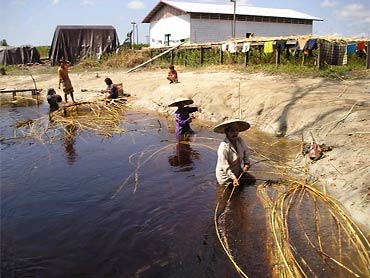
Villagers wash rattan, strand by strand, in the river. (Photos
by David Hall)
|
The rattan facts
 |
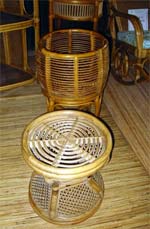
Rattan furniture
|
So what is rattan? To put it simply, think of most of the furniture that you
thought was made from bamboo. In reality, if it is bent into a curve, then
it will be rattan. Even if it isn’t bent, it’s probably rattan!
And if it’s rattan, it’s likely to originate from Indonesia; the
country accounts for around 80% of the world’s raw rattan products.
Raw rattan grows in the rain forest. Its favorite location is in what forestry
guys tend to call secondary forest, where the trees are fairly young and a
lot of light penetrates to the forest floor. Primary forest tends to have much
bigger, taller trees, and the ambient light levels on the forest floor tend
to be lower. For rattan at least, these are the major differences. Unlike bamboo,
which grows almost like a tree, rattan is a creeping plant that closely resembles
the stem of a rose. It grows from the forest floor, using the trees to climb
upward, and is typically harvested by the rattan farmers when it is years old.
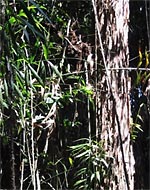
Rattan grows in a forest "garden."
|
 |
Rattan
is great for a sustainable development project because the local farmers actually
plant rattan in “gardens,” and the rattan needs trees
to grow. These gardens are between 2 and 5 hectares in size (5 to 12 acres)
and typically yield around 1.3 metric tons of rattan every couple of years.
Because the trees are left standing when rattan is harvested, the raw material
can be classified as a non-forest product, and can therefore be exempt from
forestry product tariffs and restrictions – at least in theory. In practice,
local NGOs are having to lobby the Indonesian government for a reclassification
of rattan, which currently is classified as a forest product and not a cultivated
plant.
 |
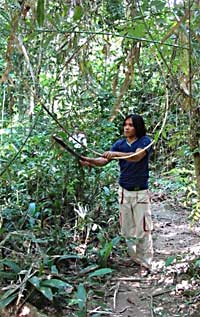
Harvesting rattan, one machete chop at a time.
|
The first step in the rattan product development process is harvesting. This
is labor-intensive and is typically carried out by teams of villagers, who
take turns harvesting their gardens with other local farmers helping out. To
watch the farmers cut and strip the rattan of its thorny outer layer is pretty
amazing. These guys climb the trees, get out their machetes and then start
hacking away – only its not really hacking. It requires great skill to
first cut the rattan and then, with a secondary blow, split off the outer layer
and peel out the core rattan.
Once the rattan has been harvested from the garden, it has to be prepared
before it can be used in weaving, furniture making or any other rattan-based
craft. The first step is to wash the rattan in the river to remove any stains
and clean the product, stripping away the layer of silica that tends to coat
the core rattan.
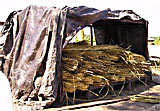
A rattan smoker, loaded with raw material.
|
 |
The next step is to cure the rattan, turning its color from a pale green into
the yellow that most people are familiar with by smoking it in sulphur fumes.
The raw, washed rattan is loaded into what looks like a wood-framed tent that
has its floor about a foot off the ground. Many “bushels” of raw
rattan are piled on top of one another until the wooden frame is full. The
frame is then covered with tarpaulin, which is secured to the ground using
stone weights. The sulphur is ignited and placed under the tent, and the smoking
process begins. It usually takes about a day or so to complete this curing
and smoking process.
 |
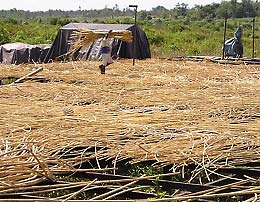
Rattan is spread on outdoor racks to dry in the
blistering sun.
|
After curing, the rattan has to be dried to remove excess moisture and make
the product suitable for use. This is done outside under the hot equatorial
sun, and takes perhaps another two or three days to complete.
After drying, the rattan is ready for use. It can further be processed into
peel for weaving, or core products that are flexible and used for binding and
craft materials. Around 60% of the rattan goes into the furniture business,
the majority of which is located in Java, but some is used by local people
for making crafts.








